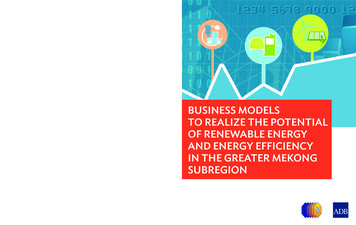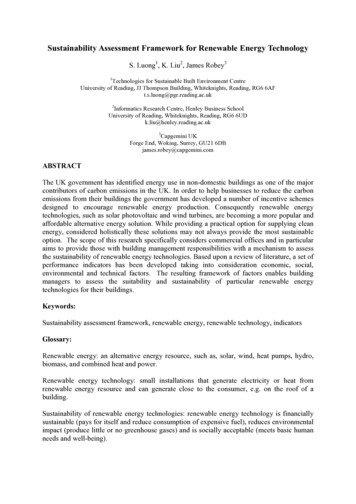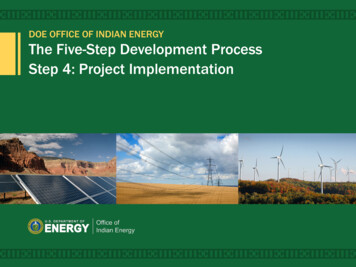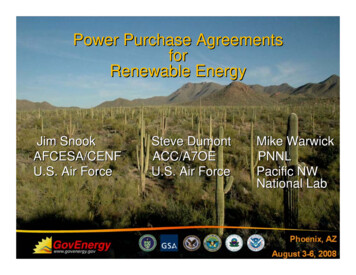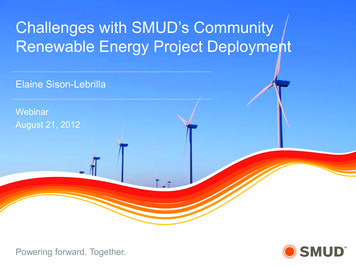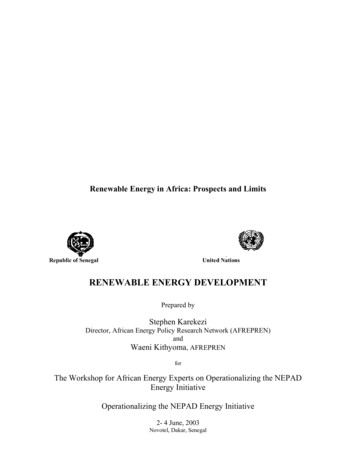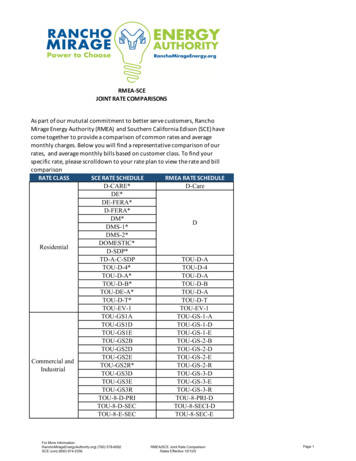
Transcription
Renewable vs. non-renewable energy sources, forms andtechnologies prepared by. A.Gritsevskyi, IAEAObjective of this paper is to provide International Recommendations forEnergy Statistics (IRES) with suggested definition of renewable and nonrenewable energy grouping and relevant discussion that could be used inupdated energy statistics manual. Second objective is to give a shortliterature overview with relevant definitions and argumentation. Suggestion onhow renewable energy forms and corresponding transformation should bereflected in “basic” energy statistics and energy balances are largely outsideof the scope of this paper.Why is it important to introduce categorization based on renewableversus non-renewable energy?Historically renewable energy was first energy humankind used. Going fromuse of fuelwood as a source of cooking and providing heat to using windenergy for transportation and later as a source of mechanical energy in firstmachinery renewables played absolutely essential role for development inpreindustrial time.It hard to say for sure when and in what source grouping renewables/nonrenewables was introduced (my colleagues from IAEA library did not finishedresearch on that topic yet), but most probably it become widely used around1973-1975 as outcome of the work on energy security issues andsustainability.There is clearly more than one reason to introduce such categorizationzz“do we have sufficient energy resources?” and energy security. Also fromscientific point of view all energy sources we know within a defined system(Earth) are finite some energy, for example energy obtained from fusionprocess, could be considered practically inexhaustible. Some energysources have limited quantities and occurrence (fossil fuel, uranium) andcould be depleted. Other, coming from nature, like solar radiation andmechanical energy produced by gravitational interactions in system EarthMoon are limited in their flow/flux but virtually not depletable.Sustainability of using energy sources. All limited resources includingenergy resources should be used in a manner that does not to compromiseneeds of future generations. Amount of energy coming from exhaustible vs.inexhaustible resource is important indicator of sustainability (which is notperfectly defined term as well).
zEnvironmental impact and climate change. Use of “conventional” energytechnologies based on fossil fuels had some records of seriously highimpact on local and regional environment. It is largely accounted forsignificant growth of carbon dioxide and other “green” gases inatmosphere. Alternatively some energy technologies taking energy fromnatural flows like solar radiation and wind were viewed as environment“neutral” and potentially providing “clean” energy for unlimited period oftime. Also, so far were have no technology without negative effect onenvironment some of them do have considerably lower and morecontrolled undesirable outcomes.What is in UN F series manuals?:Manual 44E does not differentiate between renewable and non-renewableenergy.In 29E on page 4 there is section E “New sources of energy” renewables arementioned. They are listed (along with nuclear energy) as well as “classical”biomass production, but in cases of conventional biomass products manualsuggest that “alternative energy sources might be more efficient”. In the samemanual on page 8-9 par. 29 the way energy sources are mentioned it issuggesting that “hot rocks” (geothermal) is not part of renewable sources(they are explicitly listed separately). There are number of places discussingthe way renewable energy should be reflected in energy balances. And onpage 29 par.106 there is an attempt to give working definition:106. "Renewable sources of energy" is a convenient label for the energyobtainable from biomass, solar radiation temperature differences that producecurrents in deep oceans or that are found in rocks beneath the earth'ssurface, air pressure differences that produce winds, and natural or manmade differences in water levels.In that definition it is clearly stated that geothermal and biomass arerenewable energy. At the same time few paragraphs later it put reservations108. All biomass is not necessarily renewable. Fuelwood may be 'mined' fromforests or woodlands that are all too often irreparably damaged or completelydestroyed by the practice. Alternatively fuelwood may be cropped from wellmanaged wood lots that have been specially planted with fast-growing treesor bushes suitable for this purpose. Geothermal energy, too, may or may notbe renewable depending on how deep one goes when defining the heatsource and on how accurately one knows the boundaries of the hot-rockmass; and on whether the rate of heat extract, ion from a relatively isolatedrock mass exceeds or is less than the rate at which that mass may receive
heat from a connected larger geothermal heat source.In 56E classification from 29E are mostly re-iterated:“The term "renewable" only applies to fuelwood grown and replaced at a rateat least equal to the rate at which it is cut”.
Do we have a problem(s) in distinguishing non-renewable and renewableenergy? Do we have conflicting definition in the literature?Yes we do. UN manual F-29E is in conflict with current definition used byOECD-IEA-Eurostat. F-29E is clearly indicating that fuelwood and all derivedproduct from it that is taking from forest or woodland in non-sustainablemanner is not renewable.Eurostat definition: “Renewable energy sources include renewable non-fossilenergy sources such as wind, solar, geothermal, hydro-power and energyfrom biomass/wastes. The latter refers to electricity generated from thecombustion of wood and wood wastes, other solid wastes of a renewablenature (for example, straw), biogas (including landfill, sewage, and farm gas)
and liquid biofuels, and from municipal solid waste incineration.”IEA/OECD/Eurostat definition from Energy Manual (note that it rather dealingwith energy form and not with energy source): “One can find numerousdefinitions of renewables in technical literature, including the following one:renewable energy is energy that is derived from natural processes that arereplenished constantly. Although this definition leads to some issues, dealingfor instance with the time horizon for the replenishment, it will be used as thereference in this chapter. There are various forms of renewable energy,deriving directly or indirectly from the sun, or from heat generated deep withinthe earth. They include energy generated from solar, wind, biomass,geothermal, hydropower and ocean resources, solid biomass, biogas andliquid biofuels.”EU Commission: “Renewable energy sources are defined as renewable nonfossil energy sources: wind, solar, geothermal, wave, tidal, hydropower,biomass, landfill gas, sewage treatment plant gas and biogases.”Few countries, including Finland and limat/fornybar-energi info e.html), andsome organizations like ity/peat/) label peat as “a slowlyrenewable biofuel” and a renewable source of energy.WEC is suggesting to keep peat out of both ey of energy resources 2007/peat/704.aspAnd gives that problematic definition: “New and Renewable Energy Sources: energysources including solar energy, geothermal energy, wind power, hydropower, ocean energy(thermal gradient, wave power and tidal power), biomass, draught animal power, fuelwood,peat, oil shale and tar sands.”In 1983, physicist Bernard Cohen proposed that uranium is effectivelyinexhaustible, and could therefore be considered a renewable source ofenergy. He claims that fast breeder reactors, fueled by naturally-replenisheduranium extracted from seawater, could supply energy at least as long as thesun's expected remaining lifespan of five billion years and following commondefinition of renewable resource that is not limited only to the energy it isrenewable because it is “practically inexhaustible” (see for clear.org/PADs/pad11983cohen.pdfThere are number of attempts to exclude large scale hydropower projects
from the renewable category and even to question inclusion of geothermaltechnology in case it may lead to partial depletion of resources at somespecific location.Most of the problems originate from not completely clear definition or frompossibility to (re-)interpret part of definition. Having only definition that listsrenewable or just non-renewable energy leads to problems.Principals to follow in order to provide definitionThe way to provide a definition:zPostulating (listing what it is and what it is not)zGiving criteria and checking if particular source of energy meets itzCombination of bothMost of existing definition using first method and some are based on secondone but with criteria that allows multiple interpretations. For example:z“New and renewable energy sources are energy sources including solarenergy, geothermal energy, wind power, hydropower, ocean energy(thermal gradient, wave power and tidal power), biomass, draughtanimal power, fuelwood, peat, oil shale and tar sands”, UN Glossary ofEnvironment Statistics F-67EIt is problemetic as it is not clear what is actually “new” source vs. actually renewable and what isrole of “and” in that definition.z“energy obtained from sources that are essentially inexhaustible (unlike,for example the fossil fuels, of which there is a finite supply).Renewable sources of energy include wood, waste, geothermal, wind,photovoltaic and solar thermal energy”Problem there is related to the use of “essentially inexhaustible” that is subjective and give apossibility to argue that fusion power or peat are renewables.z“all natural energy flows that are inexhaustible (i.e., renewable) from ananthropogenic point of view: solar radiation; hydropower; wind;geothermal; wave, and tidal energy; and biomass”, from “RenewableEnergy in Europe”, Energy EncyclopediaIt is suffer from similar problem, but here at least it considers only “natural” flows.z“Renewable Energy – Resources that are naturally replenishing but flow
limited. They are virtually inexhaustible in duration but limited in theamount of energy that is available per unit of time”, from “RenewableEnergy in United States”, Energy EncyclopediaIt is almost acceptable definition, but there is nothing about renewable rate.The most suitable approach for IRES would be provide criterias and explicitlylist energy sources for both categories.Suggested approach (based on M. Hoexter post “What is RenewableEnergy Anyway?”, attached)M. Hoexter approach is based on concepts of energy flux (flow) vs. energystore (see attached document for details). In that sense all non-renewableenergy is energy store. Renewable energy on the other hand, appears bothas natural energy flux and as an energy store.“Non-renewable energy sources are energy stores with zero or a minute rate of replenishmentrelative to its depletion by human beings. Most non-renewable energy sources are converted tousable energy by thermal or nuclear reactions. Non-renewable energy sources have stored thenatural energy flux of Earth’s biological and geological past or of the formation of elements in theearly history of the Universe”“Renewable energy sources are types of natural energy flux useful for human ends regularlyoccurring on or near Earth’s surface and, additionally, useful natural energy stores that arereplenished by natural flux within the timeframe of conceivable human use. All known renewableenergy sources originate in, or are close derivatives of, electromagnetic radiation of our Sun, theEarth’s and Moon’s gravitational fields and heat radiating from earth’s interior. Renewable energysources are practically inexhaustible though some sources such as geothermal and ocean thermalenergy conversion may become locally depleted by human use at a rate that exceeds replenishmentby natural flux.”Differences between energy source, form and technologyDifficulties in categorizing, at least at some extend, emerged from mixingdifferent energy terms: source, form and technology. There are someinconsistencies in how it is used by UN Environmental Statistics (F67E)/OECD vs. IEA/Eurostat Manual.F-67E: “Energy Sources: all solid, liquid and gaseous fuels; electricity;uranium; steam and hot water; and the traditional fuels such as fuelwood,charcoal, vegetal and animal wastes”.IEA/Eurostat:”The energy source refers to the kinetic (e.g. hydro, wind),thermal (e.g. nuclear, geothermal) or combustible fuel used as the input togenerate electricity or heat.” and later manual describes energy commoditiesand their transformations by using term “form”. It is common practice and
consistent with scientific literature.What is defined by F-67E as “energy source” is actually “energy form”.Energy that entering defined system (energy system) coming from somesource (fossil, sun, wind). Energy inside of the system transformed from oneform to another (jet fuel, biogas, electricity) and transformation (changing inform), transportation (moving in space), storing (shifting energy in time) isdone by energy technology that takes energy form as both input and output.Hybrid renewable technology and associated accountingEnergy technology may use multiple energy input forms and in some cases,like hybrid of natural gas-fired combined-cycle generating equipmentintegrated with solar thermal generating equipment, some are renewable andsome are not. Output, which in that particular case electricity and heat, is not100 % coming from renewable source and corresponding energy forms inenergy balances should be reported in consistent way (effectively capturedheat from solar part in energy units as well as gas input). This is in aggrementof Recommendation #16 of Oslo group.Suggestions (explicit) to address “gray areas”zzzzzpeat – non-renewable energy form due to low and slow renewable rate,consequently technologies that using peat are non-renewable and itrequire check with ISEC for peat extraction activities. Origin of peat isbiomass and it came from renewable energy sourcegeothermal – renewable. Some use may harm amount of the energyeffectively available at specific locationfuelwood and all derived products – renewable(?) but should bediscussed separately with environment statistics expertshydropower, both large and small scale – renewable. The samecomment as for geothermal is applicablefission and fusions materials based – non-renewable, as potentialeffectively replenishing cycle could be only viewed as human made incontrast to some source geothermal energyThis should bring UN manuals in consistence with IEA/Eurostat adoptedcategorization.
In that sense all non-renewable energy is energy store. Renewable energy on the other hand, appears both as natural energy flux and as an energy store. "Non-renewable energy sources are energy stores with zero or a minute rate of replenishment relative to its depletion by human beings. Most non-renewable energy sources are converted to
